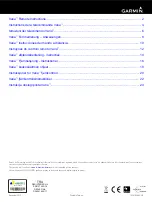
PNI Sensor Corporation
Doc #1016102 r03
RM3000-f & RM2000-f Sensor Suite User Manual
– August 2012
Page 26 of 42
MODE
The MODE pin establishes whether communication with the 3D MagIC will comply
with Standard Mode protocol (see Section 5) or Legacy Mode protocol (see Section
6). The MODE pin should be grounded (connected to DVSS) to operate in Standard
Mode, and set HIGH (connected to DVDD) to operate in Legacy Mode.
SCLK (SPI Serial Clock Input)
SCLK is a SPI input used to synchronize the data sent in and out through the MISO
and MOSI pins. SCLK is generated by the customer-supplied master device and
should be 1 MHz or less. One byte of data is exchanged over eight clock cycles.
Data is captured by the master device on the rising edge of SCLK. Data is shifted out
and presented to the 3D MagIC on the MOSI pin on the falling edge of SCLK, except
for the first bit which must be present before the first rising edge of SCLK.
SSN (SPI Slave Select)
This signal sets the 3D MagIC as the operating slave device on the SPI bus. The SSN
pin must be LOW prior to data transfer in either direction, and must stay LOW during
the entire transfer.
The SSN pin must transition from HIGH to LOW prior to initiating a multi-axis
measurement (MAM) command and prior to reading or writing to the Cycle Count
Register or Clock Divide Register. It must stay LOW for the remainder of the
operation.
After communication between the 3D MagIC and master device is finished, the SPI
bus can be freed up (SSN pin set HIGH) to communicate with other slave devices
while the 3D MagIC takes a measurement or is idle.
MISO (SPI Serial Out)
MISO is a SPI output that sends data from the 3D MagIC to the master device. Data
is transferred most significant bit first and is captured by the master device on the
rising edge of SCLK. The MISO pin is placed in a high impedance state if the 3D
MagIC is not selected (i.e. if SSN=1).
MOSI (SPI Serial In)
MOSI is a SPI input that provides data from the master device to the 3D MagIC.
Data is transferred most significant bit first. Data must be presented at least 50 ns
before the rising edge of SCLK, and remain valid for 50 ns after the edge. New data
typically is presented to the MOSI pin on the falling edge of SCLK.
















































